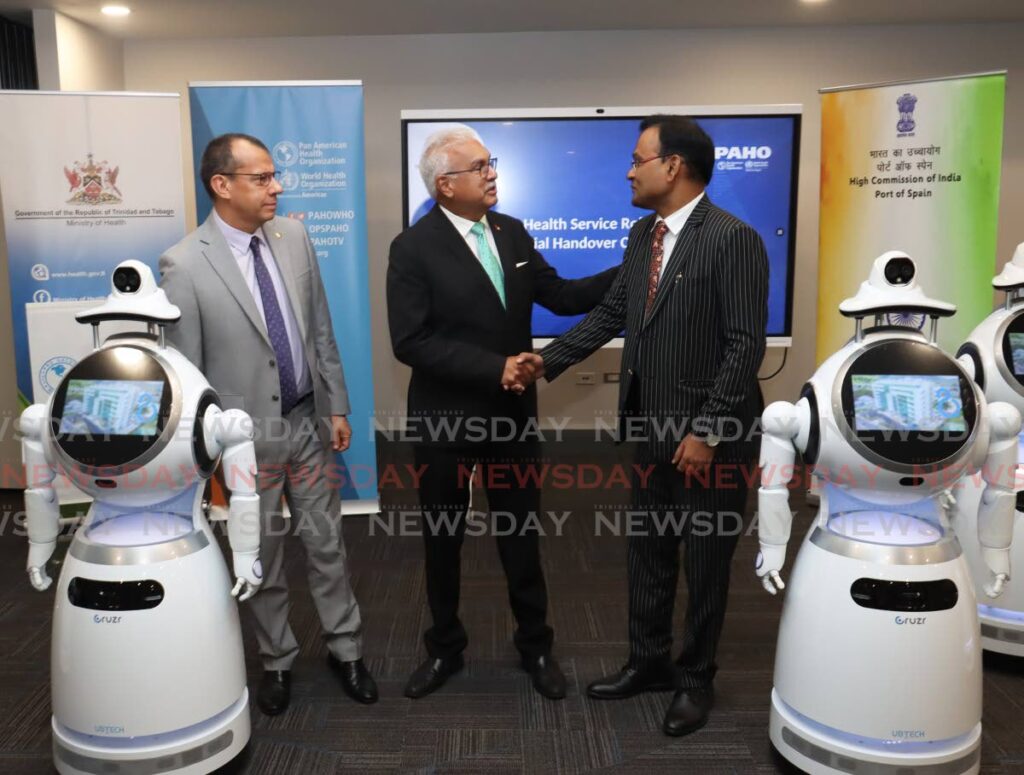Jury still out on medical robots in health sector

THE introduction of eight robots to Trinidad and Tobago's healthcare system has been stirring up conversation.
Some have welcomed the move, while others are fearful of a repeat of Will Smith's 2004 movie I, Robot.
The Health Ministry said the robots can record patients' temperatures, monitor vitals, provide information about the ministry and even facilitate remote communication between staff and patients.
The robots were funded by the India – UN Development Partnership Fund.
The Cruzr robots, manufactured by Ubitech Robotics, are used across a range of sectors including retail, tourism, banking, delivery, cleaning among others.
On its website, it lists its key features as personalised greetings, professional explanations, intelligent guiding, data management, and multimodal entertainment interaction.
Similar to Roombas and other cleaning/vacuum robots, Cruzr scans the entire room in which it is placed to allow smooth navigation. It has 15 degrees of freedom and is able to mimic human movement.
"The highly anthropomorphic design of Cruzr robot enables it to move with the same flexibility and freedom as a human, optimising user interaction and operational efficiency," the website says.
Standing at 3.93 feet and 45 kg, Cruzr is able to last up to eight hours with continuous use, and then automatically returns to its charging station.
In addition, a robot specifically meant for sanitisation has been placed at the Scarborough and Arima Hospitals.
Robot-assisted surgeries have been performed in Trinidad and Tobago before, and many local surgeons have also undergone training for same,
Success in Rwanda
Five of these robots were introduced to Rwanda's healthcare system in 2020 during the height of the covid19 pandemic. The WHO had said this was done to "minimise contact time with confirmed cases and reduce the risk of contamination of health professionals in treatment centres."
At the handing over ceremony on August 17, PAHO (Pan American Health Organization) representative to Trinidad and Tobago Dr Gabriel Vivas Francesconi said Rwanda concluded the robots had a “valuable role.”
Representatives from Rwanda’s health ministry, PAHO, WHO, UTT (University of Trinidad and Tobago) and Trinidad and Tobago’s health ministry held several discussions before this, he added.
“The Trinidad and Tobago team identified the importance of developing a change management approach including a communication plan to support the acceptance of the health services robots by the healthcare providers as well as the community.”
Francesconi also said training for healthcare workers to use these robots has already started and is ongoing.
Newsday sent an e-mail to Rwanda’s health ministry asking if the robots are still in use and about their impact, but only an acknowledgment of receipt of the e-mail was provided.
Public response
Newsday asked its readers for their thoughts on the new technology.
Wayne Haynes said, "Robots in the medical field are transforming how surgeries are performed, streamlining supply delivery and disinfection, and enabling providers to focus on engaging with and caring for patients."
Crystal Dipsingh-Bachoo said the intention behind the move is good. However, she added, "Like many other things, the results depend on its execution and maintenance by any governing party, such as the blimp, body cameras for police officers, the Children's Hospital..."
One Instagram user said, "It's a donation, we will gladly accept it but it will be really comical seeing high-tech robots in the under-resourced hospitals with overworked, underpaid doctors."
Another user said it is a step in the right direction, but wondered if the donation could have "been different and assisted with more immediate issues like improvement of facilities, increased human resources and medical equipment."
A nursing student told Newsday, "Best case scenario, they will be a mildly useful novelty for a while. The RHAs (regional health authorities) don't have the IT personnel trained in repairing or configuring these robots. They will quickly end up shuffled in some closet awaiting repair."
Miriam Khan said, "I don't want a robot attending to me in hospital."
Jason Singh likened it to "icing on a saltine cracker."
He said, "Would have been better off to improve the curriculum for healthcare professionals, provide more training for bedside manner and courtesy/professionalism for healthcare workers, and improve the actual buildings health is practised in.
"The point of vitals is for the tech to create a baseline report to pass on to the doctor and establish a relationship with your patient, and assess the situation....to better help the patients."
And Leonora Baboolal said the robots work well in other countries.
Others also said they would prefer to interact with a robot than human staff at health facilities.

Comments
"Jury still out on medical robots in health sector"